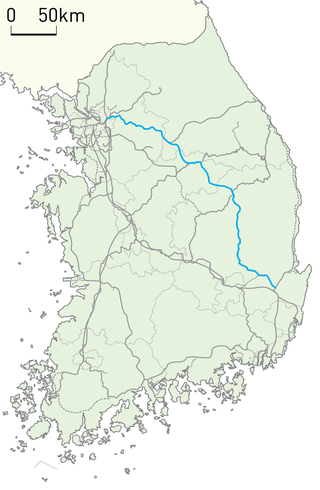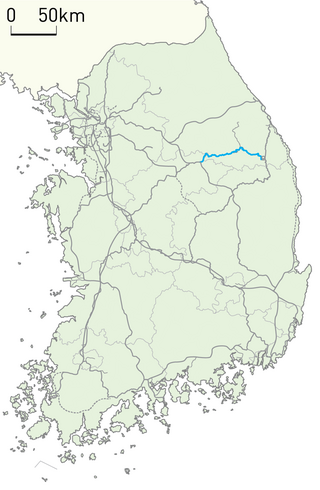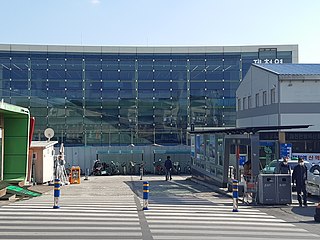
Gangwon State, is a Special Self-Governing Province of South Korea. It is known as the largest and least densely populated subdivision of South Korea. Gangwon is one of the three provinces in South Korea with special self-governing status, the others being Jeju Province and Jeonbuk State. Gangwon is bordered on the east by the Sea of Japan, it borders Gyeonggi Province to the west, North Gyeongsang Province and North Chungcheong Province to the south, and the Military Demarcation Line to the north, separating it from North Korea. In the 1945 division of Korea, the historical Gangwon Province was divided in half, and remains so to this day. The northern portion is administered by the DPRK and is called Kangwŏn Province

North Gyeongsang Province is a province in eastern South Korea, and with an area of 19,030 km2 (7,350 sq mi), it is the largest province in the Korean peninsula. The province was formed in 1896 from the northern half of the former Gyeongsang province, and remained a province of Korea until the country's division in 1945, then became part of South Korea.

Samcheok is a city in Gangwon-do, South Korea. To the west are the Taebaek Mountains, which form a high flat plain of more than 1,000 meters, and to the east, the coastal plain slopes sharply. It borders Donghae City in the north, Uljin County in Gyeongsangbuk-do in the south, and Taebaek City in the west. It covers an area of 1,185.86 km2 and has a coastline of 58.4 km.The city hall is located in Gyo-dong, and the administrative area includes 2 districts, 6 villages, and 4 dongs. The tree symbolizing the city is the zelkova, the bird is the seagull, and the flower is the azalea. Samcheok has the lowest population density of any autonomous city in Korea.

Taebaek is a city in Gangwon province, South Korea. Its name is shared with that of the Taebaek Mountains. Situated at an elevation of 650 to 700 m, Taebaek is the second highest city in South Korea, after Yongin.

The Jungang line is a railway line connecting Cheongnyangni in Seoul to Moryang in Gyeongju in South Korea, traversing central South Korea from the northwest to the southeast. It is also referred to as the rail line of the Seoul Metropolitan Subway from Yongsan station to Jipyeong station. The section from Cheongnyangni to Dodam was designated as a semi-high-speed railway.

The Taebaek Mountains (Korean: 태백산맥) are a mountain range that stretches across North Korea and South Korea. They form the main ridge of the Korean peninsula.

Bonghwa County (Bonghwa-gun) is a county in North Gyeongsang Province, South Korea. It lies inland, at the northern edge of the province, and borders Gangwon province to the north. To the east it is bounded by Yeongyang and Uljin counties, to the south by Andong, and to the west by Yeongju. The county is ringed by the Taebaek and Sobaek Mountains, the highest of which is Taebaeksan (1,566.7m). Because of its mountainous location, Bonghwa has a colder climate than most of the province, with an average annual temperature of 10 °C (50 °F).
Gwandong is a region coinciding with the former Gangwon Province in Korea. Today, the term refers to South Korea's Gangwon Province and North Korea's Kangwon Province. The name is often used to refer to people residing in the region.

The Yeongdong Line is a line of Korail. It connects Yeongju in North Gyeongsang Province with Gangneung in Gangwon Province. From Yeongju, it crosses the Taebaek Mountains and reaches the Sea of Japan at Donghae, thence proceeding north to Gangneung.

The Mugunghwa-ho (Korean: 무궁화호) is a class of train operated by Korail, the main railway operator of South Korea. Mugunghwa trains are Korail's slowest tier of trains stopping at a number of towns and villages, and operating over a number of lines that are not served by other trains. Journey times are generally twice that of KTX trains and 25% longer than ITX express trains.

Cheongnyangni Station (Korean: 청량리역) is a major railway station located at Dongdaemun-gu, Seoul, South Korea. It serves as a terminus for passenger trains serving the eastern part of South Korea. KTX, ITX-Cheongchun, and Mugunghwa-ho trains terminates or stops at this station. Several Seoul Metropolitan Subway lines serve the station. These are: Seoul Subway Line 1, the Gyeongchun Line, the Suin–Bundang Line and the Gyeongui–Jungang Line.

Taebaek Line is a single-track electrified railway mainline connecting Jecheon station to Baeksan station in South Korea. At its two ends, the Taebaek Line connects to the Jungang Line and Yeongdong Line. The line was originally two spur lines, which were built across difficult mountainous terrain in stages, before a connection was built. The line includes the steepest section of the South Korean network, a short parallel line that is operated as a second track on the section includes South Korea's longest spiral tunnel. The centerpiece of the last-built section west of Taebaek, is a tunnel that was the longest in South Korea at the time of its construction, and Chujeon Station at the eastern end of the tunnel is the highest altitude in South Korea at 855 m (2,805 ft). In passenger traffic, the line is served by cross-country passenger trains connecting the capital Seoul with Korea's east coast. In freight traffic, while coal transport declined, the line carries significant cement transport. In the winter, regular special trains take tourists along the scenic route.

Tilting Train Express (TTX) or Hanvit 200 is a South Korean experimental tilting train, which is currently being tested by the Korea Railroad Research Institute (KRRI).

Taebaeksan, also known as Mount Taebaeksan or Mount Taebaek, is a South Korean mountain with several important peaks of the Taebaek mountain range, or the Taebaek Jeongmaek Range. It is an important mountain in the Baekdu-daegan mountain range, the point where it turns west after running along Korea's east coast for a long distance. Its territory stretches from the city of Taebaek in Yeongwol-gun County, Gangwon-do Province to Bonghwa-gun County, Gyeongsangbuk-do Province, and it was designated South Korea's 22nd national park on 22 August 2016. It has an elevation of 1,566.7 m (5,140 ft).

The Taebaek Mountains is a 1994 South Korean film directed by Im Kwon-taek. It is named for the Taebaek Mountains on the Korean peninsula.

Cheongnyangni-dong is a neighbourhood, dong of Dongdaemun-gu in Seoul, South Korea.

Jo Jeong-rae is a novelist from South Korea, best known as the author of the best-selling novels Taebaek Mountain Range, Arirang, and Han River'
Gangwon No.1 Broadcasting or G1, formerly Gangwon Television Broadcasting (GTB) is a Radio and TV station in Gangwon Province, affiliated with the SBS Network.

Jecheon station is a railway station in the city of Jecheon. It is on the Jungang Line and the Taebaek Line. This station is also served by all Chungbuk Line passenger services.

Whisper is a 2017 South Korean television series starring Lee Bo-young, Lee Sang-yoon, Kwon Yul, and Park Se-young. It aired on SBS from March 27 to May 23, 2017, on Mondays and Tuesdays at 22:00 (KST) for 17 episodes.


















